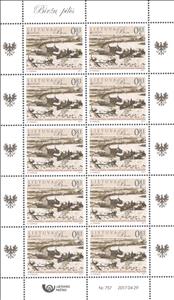Mini Sheet: Biržai Castle (Lithuania 2017)
Biržai Castle (Lithuania 2017)
29 April (Lithuania ) within release Europa (C.E.P.T.) 2017 - Castles goes into circulation Mini Sheet Biržai Castle face value 8.10 Euro
| Mini Sheet Biržai Castle in catalogues | |
|---|---|
| Michel: | Mi: LT 1250KB |
Mini Sheet is vertical format.
Author D. VildžiūnasAlso in the issue Europa (C.E.P.T.) 2017 - Castles:
- Stamp - Birzai face value 0.81;
- Stamp - Klaipeda face value 0.81;
- Mini Sheet - Klaipėda Castle face value 8.10;
- Mini Sheet - Biržai Castle face value 8.10;
Mini Sheet Biržai Castle it reflects the thematic directions:
Architecture (Latin architectura, from the Greek ἀρχιτέκτων arkhitekton "architect", from ἀρχι- "chief" and τέκτων "builder") is both the process and the product of planning, designing, and constructing buildings and other physical structures. Architectural works, in the material form of buildings, are often perceived as cultural symbols and as works of art. Historical civilizations are often identified with their surviving architectural achievements.
A castle (from Latin: castellum) is a type of fortified structure built in Europe and the Middle East during the Middle Ages by European nobility. Scholars debate the scope of the word castle, but usually consider it to be the private fortified residence of a lord or noble. This is distinct from a palace, which is not fortified; from a fortress, which was not always a residence for nobility; and from a fortified settlement, which was a public defence – though there are many similarities among these types of construction. Usage of the term has varied over time and has been applied to structures as diverse as hill forts and country houses. Over the approximately 900 years that castles were built, they took on a great many forms with many different features, although some, such as curtain walls and arrowslits, were commonplace.
A fortification (also called a fort, fortress, fastness, or stronghold) is a military construction designed for the defense of territories in warfare, and is used to establish rule in a region during peacetime. The term is derived from Latin fortis ("strong") and facere ("to make").
A palace is a large residence, often serving as a royal residence or the home for a head of state or another high-ranking dignitary, such as a bishop or archbishop. The word is derived from the Latin name palātium, for Palatine Hill in Rome which housed the Imperial residences



